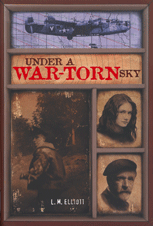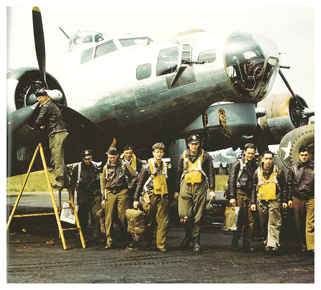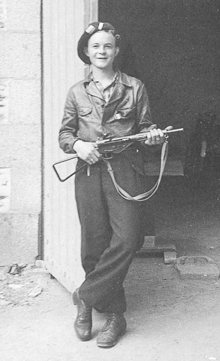
[ Back to Historical Fiction ] -> [ Back to Under A War-Torn Sky ]
How Much is True
Under a War-Torn Sky

WWII is full of such poignant moments. If you know someone who survived it, turn on a tape recorder and encourage him or her to share with you. Their anecdotes will bless you with incredibly moving storylines, rich with life-or-death crises and admirable characters who met them with profound courage and compassion. As Winston Churchill said: “Never have so many owed so much to so few.”
Historical fiction combines fact and imagination. Typically the protagonist, the hero or heroine, is fictitious, but the events, political figures, and issues of the book are true. The plot and the moral challenges the hero must face grow out of the time period. Details of everyday life need to be absolutely correct to bring the setting to life and to advance character development. For instance, when Henry is in the Vercors, the natives serve him walnut wine and blue cheese, common food in the region. Such idiosyncratic fare helped illustrate how unsophisticated and unprepared for foreign delicacies Henry is. The fact the American musician Louis Armstrong was so popular in France during the 1940s gave me a way for Henry and one of his teenage guides to connect. Singing together, they overcome their distrust and the language barrier between them. It also showed how young those boys were, how innocent really, in a bittersweet little scene of their pretending to play trumpets as they cross over a mountain pass, warily watching the sky for Nazi planes.
Readers always ask how much of Under a War-torn Sky actually happened, how much is my father’s true story. Henry Forester is not my father. Henry does have my father’s resilient and kind personality and his amazing homecoming. His strained relationship with Clayton resembles that between my father and my steely grandfather, who managed to keep his farm during the Depression when neighbors all around him lost everything they had. My father did mangle his French once as Henry does with the old schoolteacher (I don’t want to give away how for those who haven’t yet read the novel). My father briefly met individuals like Pierre and Claudette (Patsy, the young woman Henry loves, is not my mother, by the way. She is purely my creation. My parents met after the war).

Under a War-torn Sky, then, is also the story of the teenagers, young children, women, and old men who risked everything to save lives and to resist Hitler’s oppression. I learned of them by reading many memoirs. In these first-person accounts, I found the inspiration for characters like Madame Gaulloise. She is based on several cosmopolitan women who used their wit and chic elegance to intimidate and baffle the Nazis, among them Lucie Aubrac and a Parisian who went by Marie-Claire, the combined name of her two cats (and no, Madame Gaulloise’s clever poodle is not a factual dog. But using a nervous and rambunctious animal to distract the Nazis was a frequent tactic of the inventive and resourceful Resistance or maquis). The Morvan maquis leader I named Martin is an amalgamation of many Frenchmen who had no military training but decided to take up the fight. One maquisard captain had been a dance-band leader before the war, another a veterinarian. He began running a rat line when he was walking home from his clinic and literally ran into an American boy, dazed from bailing out of his burning airplane, dragging his parachute with him through the streets. The girl who helps Henry evade his prison guards on the train is based on a 20-year-old agent code-named “Michou.” She spoke several languages fluently and used that linguistic talent and quick-witted play-acting to guide 150 Allied airmen to maquis safe houses.
These brave individuals typically acted alone, without the help or reassurance of a group. Often they made split-second decisions to shield an American on the run, pulling him to safety as a patrol passed. Or they might stand in the shadows for hours after curfew waiting to pick up a lost and frightened airman or brazenly escort him through checkpoints with false papers and pretend bluster. Caught, they would be interrogated, their family and friends probably rounded up as well, and then executed. They put themselves and those they loved into terrible peril while their neighbors might collaborate with the Nazis out of fear or for reward money or because they agreed with Hitler’s hatred of Jews.

I traveled to France to better understand the landscape, the people of WWII, and what happened to civilians during the fight for liberation. I stood for a long time in front of one display in a small Resistance museum in the Morvan region, just a few miles from Dun-les-Places, where the Nazis gunned down an entire village because a handful of them were members of the local maquis. I was transfixed by a wall of black and white photos of Resistance fighters and the villagers who helped them. I realized then, really for the first time, that had it not been for these brave people, my father might not have survived. I and my children would not exist.
What haunted me most were the clear-eyed, hopeful faces of several teenagers who disappeared, never to be found. Also displayed is a letter by a 23-year-old Paul Sarrette, who was killed by the Nazis. He wrote, “I am going to fight, not for a word, not for glory or for a flag, but for you—men, women, and children—so that you may live without knowing the horrors of a war.”
Leaving the museum, visitors pass under an arch that states: “May you think sometimes of the reasons you are free.” I hope Henry Forester and Under a War-torn Sky do that for you.
WWII is full of such poignant moments. If you know someone who survived it, turn on a tape recorder and encourage him or her to share with you.
